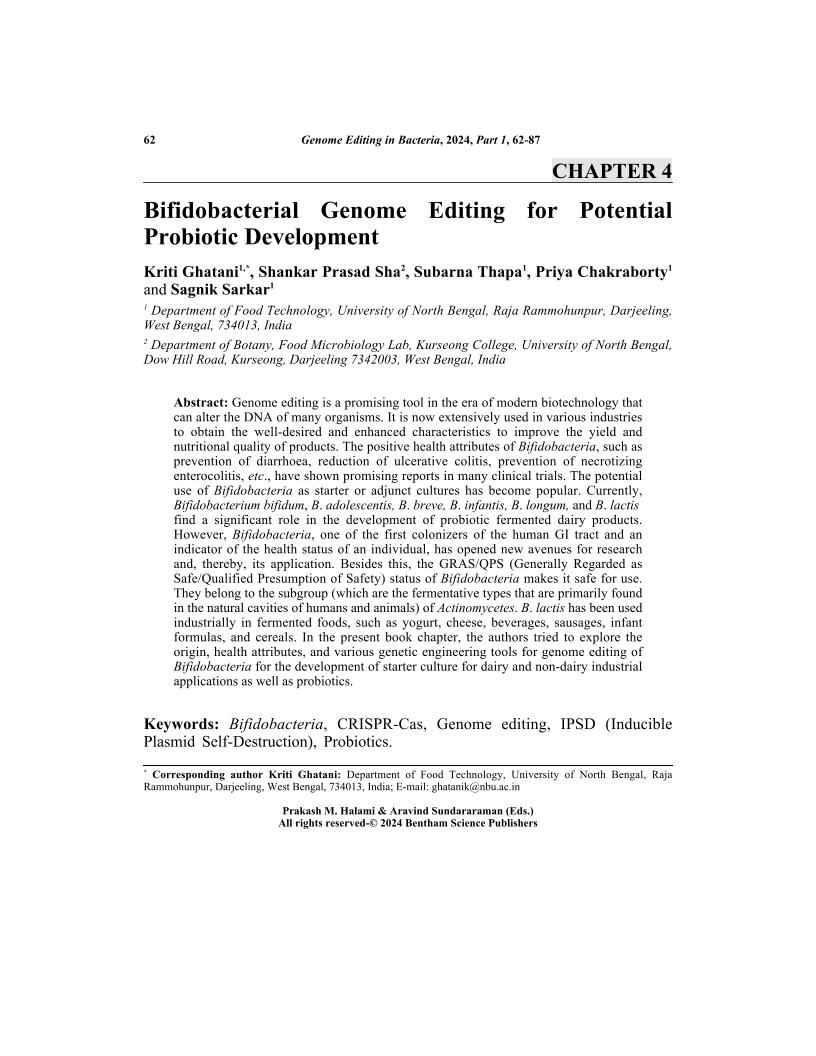Bifidobacterial Genome Editing for Potential Probiotic Development

- Authors: Kriti Ghatani1, Shankar Prasad Sha2, Subarna Thapa3, Priya Chakraborty4, Sagnik Sarkar5
-
View Affiliations Hide AffiliationsAffiliations: 1 Department of Food Technology, University of North Bengal, Raja Rammohunpur, Darjeeling, West Bengal, 734013, India 2 Department of Botany, Food Microbiology Lab, Kurseong College, University of North Bengal, Dow Hill Road, Kurseong, Darjeeling 7342003, West Bengal, India 3 Department of Food Technology, University of North Bengal, Raja Rammohunpur, Darjeeling, West Bengal, 734013, India 4 Department of Food Technology, University of North Bengal, Raja Rammohunpur, Darjeeling, West Bengal, 734013, India 5 Department of Food Technology, University of North Bengal, Raja Rammohunpur, Darjeeling, West Bengal, 734013, India
- Source: Genome Editing in Bacteria (Part 1) , pp 62-87
- Publication Date: February 2024
- Language: English
Bifidobacterial Genome Editing for Potential Probiotic Development, Page 1 of 1
< Previous page | Next page > /docserver/preview/fulltext/9789815165678/chapter-4-1.gif
Genome editing is a promising tool in the era of modern biotechnology that can alter the DNA of many organisms. It is now extensively used in various industries to obtain the well-desired and enhanced characteristics to improve the yield and nutritional quality of products. The positive health attributes of Bifidobacteria, such as prevention of diarrhoea, reduction of ulcerative colitis, prevention of necrotizing enterocolitis, etc., have shown promising reports in many clinical trials. The potential use of Bifidobacteria as starter or adjunct cultures has become popular. Currently, Bifidobacterium bifidum, B. adolescentis, B. breve, B. infantis, B. longum, and B. lactis find a significant role in the development of probiotic fermented dairy products. However, Bifidobacteria, one of the first colonizers of the human GI tract and an indicator of the health status of an individual, has opened new avenues for research and, thereby, its application. Besides this, the GRAS/QPS (Generally Regarded as Safe/Qualified Presumption of Safety) status of Bifidobacteria makes it safe for use. They belong to the subgroup (which are the fermentative types that are primarily found in the natural cavities of humans and animals) of Actinomycetes. B. lactis has been used industrially in fermented foods, such as yogurt, cheese, beverages, sausages, infant formulas, and cereals. In the present book chapter, the authors tried to explore the origin, health attributes, and various genetic engineering tools for genome editing of Bifidobacteria for the development of starter culture for dairy and non-dairy industrial applications as well as probiotics.
-
From This Site
/content/books/9789815165678.chapter-4dcterms_subject,pub_keyword-contentType:Journal105

